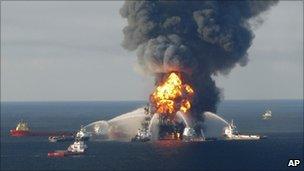US oil spill: Transocean 'contributed' to Gulf disaster
- Published

A lax safety culture and poorly working kit aboard the Deepwater Horizon oil rig contributed to last year's explosion, the US Coast Guard says.
In a report on the incident, which killed 11 and caused a massive spill, the agency criticised the practices and training of rig owner Transocean.
It said equipment was poorly maintained and alarms and automatic shutdown systems did not work properly.
A Transocean spokesman on Friday rejected the findings.
In a 288-page report released just over a year after the accident, the Coast Guard found actions by Transocean and the oil rig crew hindered their ability to prevent or contain the disaster.
"Deepwater Horizon and its owner, Transocean, had serious safety management system failures and a poor safety culture," the report said.
"Collectively, this record raises serious questions whether Transocean's safety culture was a factor that contributed to the disaster."
'Lax oversight'
Transocean spokesman Brian Kennedy told the Associated Press that the Coast Guard had inspected the Deepwater Horizon seven months before the blowout and deemed it in compliance with safety standards.
"We strongly disagree with - and documentary evidence in the Coast Guard's possession refutes - key findings in this report," he said in a statement.
Overnight on 20 April 2010, Transocean's Deepwater Horizon burst into flames while drilling a well for BP.
In the months that followed, more than 200 million gallons (780 million litres) of oil flowed in the Gulf of Mexico from the well, soiling hundreds of miles of coastline in the worst US oil spill in history.
The Coast Guard also cited lax oversight by the Republic of the Marshall Islands, the nation in the Pacific where Transocean had registered the rig.
It said national regulators had effectively "abdicated" their inspection responsibilities by contracting them out to third parties.
Crew 'complacent'
The Coast Guard report said evidence indicated the explosion occurred when electrical equipment ignited a cloud of flammable gas that had flowed up from the well.
It said electrical equipment may have been incapable of preventing ignition, and cited a 2010 inspection audit that found some equipment on board was in "bad condition" and was "seriously corroded".
"Because of these deficiencies, there is no assurance that the electrical equipment was safe and could not have caused the explosions," the Coast Guard said.
Among other contributing shortcomings, the report found:
- Gas detectors on the oil rig were not set up to shut down the flow from the well automatically in an emergency, nor to shut down the air flow into the rig's engine room
- Audible alarms on some gas detectors had been turned off to avoid disturbing the crew with false alarms
- The rig's fire-fighting system depended on electricity to power water pumps and was rendered useless when the explosions caused a loss of power
- Rig crew had become complacent following routine fire drills from which drilling crew were sometimes excused
- The crew had not held training drills on how to respond to a well blowout requiring rig evacuation
On Wednesday, the first anniversary of the explosion, BP sued Transocean for $40bn (£24.37bn) in damages in an attempt to defray the oil firm's tens of billions of dollars in liabilities associated with clean-up and compensation.
In federal court in New Orleans, BP said safety systems on Transocean's Deepwater Horizon rig had failed. BP also sued the maker of the rig's blowout preventer, alleging the device failed to stop the huge oil spill that followed the explosion.
Transocean has also demanded court judgements against BP and other companies.
- Published21 April 2011
- Published20 April 2011
- Published20 April 2011